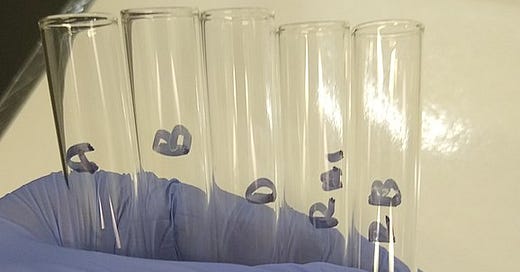I am preparing my undergraduate lectures on antibodies this year and my eye was caught by stories in the news of James Harrison and I thought, in this time of great challenges to science, it would be nice to have a positive story.
In February of this year (2025), James Harrison, passed away aged 88 years. He was the most prolific blood and plasma donor in Australia ever! It was estimated that he gave blood over 1000 times - roughly every 2 weeks between 1954 and 2018. Why? Well-because James Harrison had a rare blood type that was vital to save some baby’s lives. In fact, Harrison is credited with saving the lives of 2.4 million babies. Such was his impact that he was nicknamed the "Man with the Golden Arm.”
Why was Mr Harrison’s blood so special?
His blood plasma contained a rare antibody type called anti-D. This is an antibody made to a blood cell factors.
We all have different blood cell types- you may have heard of blood type A, or AB. These refer to the presence or absence of certain markers (antigens) on our blood cells. For example, someone who is type A will have the A antigen on their red blood
cells. They will also have antibodies to blood type B.
Our blood type is important because if we are given the wrong blood type we will attack it with our antibodies. For example, someone with blood type A will attack blood type B with antibodies against blood type B. Someone who is type AB has both A and B antigens on their red blood cells but neither A nor B antibodies in the plasma- meaning they can have blood from anyone (universal recipient blood). Conversely a blood type O has no A or B antigens but will have A and B antibodies so is suitable for donation to anyone (universal donor). As well as the main blood types A, AB, B, O there are also rhesus D antigens. You either have those or you don’t- and this is indicated with the plus or minus sign or in some places with a D. With me so far? People with the Rh negative blood type have anti-rhesus (also called anti-D) antibodies. Anti-D antibodies are REALLY important and super-rare.
A slight segue-way
The way we blood type is actually based on a really basic test called an agglutination reaction. The basic principles of this test were discovered even before we truly understood about antibodies. This is because it is SUCH a visual reaction. Antibodies are designed to stick to specific antigens- if those antigens are on red blood cells this will cause the blood cells to clump. We can see this readily with the naked eye: seen as clumping of red blood cells as this figure shows you:

In the image above you can see the two tubes on the left hand side have red blood that is uniformly mixed in the bottom of the test tube. In contrast, the 3 tubes on the right have a clumped spots in each tube indicating clumping i.e. a positive agglutination reaction.
The principle of the agglutination reaction was first discovered around 1869 by a medical student called Adolf Creite. His observations were then built upon by Leonard Landois and Karl Landsteiner several years later and it is them that are credited with the foundation of the development of agglutination for blood typing.
Anti-D antibodies
Anti-rhesus or anti-D antibodies are used to prevent a condition known variously as haemolytic disease of the newborn (HDN) or rhesus disease. This rare condition is an example of a type two hypersensitivity reaction in which antibodies are mounted against antigens on cells.
HDN occurs when there is a mismatch between the mother’s and father’s blood type and/or Rh factor. Typically when the mother is Rh- mother and the partner is Rh positive. It can occur to other blood cell types. In the first pregnancy, the mum’s blood may mix with the baby’s blood at birth- for example when the placenta breaks away. Alternatively the mixing may happen if there is a miscarriage, or possibly during a prenatal test. However the blood mixing occurs, the mother’s immune system can react against the baby’s red blood cells as if they are dangerous pathogens. This will cause the mum to develop antibodies to the baby’s red blood cells.
Typically, HDN does not occur with the mother’s first pregnancy as it takes time for the antibodies to develop and the most common trigger is during birth. As such, HDN most often occurs in future pregnancies. What happens is the mother’s antibodies that were made during the previous pregnancy can cross the placenta, attack and destroy the baby’s red blood cells. This can cause the baby to be severely anaemic and can be deadly for the baby.
The good news is it can be prevented by checking the parent’s blood types in the first pregnancy and administering intravenous immunoglobulin (IVIG) to prevent it from ever happening. This is fluid containing antibodies from blood donors and for that we need blood donors with anti-D antibodies. These antibodies bind to any free foetal red blood cells and destroy them before they can sensitise the mother. They are administered at points where there is a risk of blood mixing happening- for example during birth.
Harrison became Australia’s first and probably the most prolific anti-D immunoglobulin donor and his legacy has been absolutely incredible. His children too have become donors so his legacy of generous donation continues long after his death. His altruism has saved the lives of thousands of babies.
People who have anti-Rh (anti-D) antibodies are not common so its worth you checking if you do and maybe you can save thousands of babies too just like James Harrison did!





I've been wondering: how can one check to see if they have useful antibodies? Thanks for sharing the story and explaining the details.
Altruism, pure and simple.